Family restroom signs play a crucial role in creating inclusive and accessible public spaces. They guide individuals to designated restrooms that cater to the needs of families and individuals of all ages and abilities. This comprehensive guide delves into the various aspects of family restroom signs, providing insights into their design, placement, and significance in promoting a welcoming and equitable environment for all.
From understanding the design elements and materials used to exploring best practices for placement and maintenance, this guide offers a wealth of information to help businesses, organizations, and individuals create effective family restroom signs that meet the diverse needs of their users.
Family Restroom Sign Design
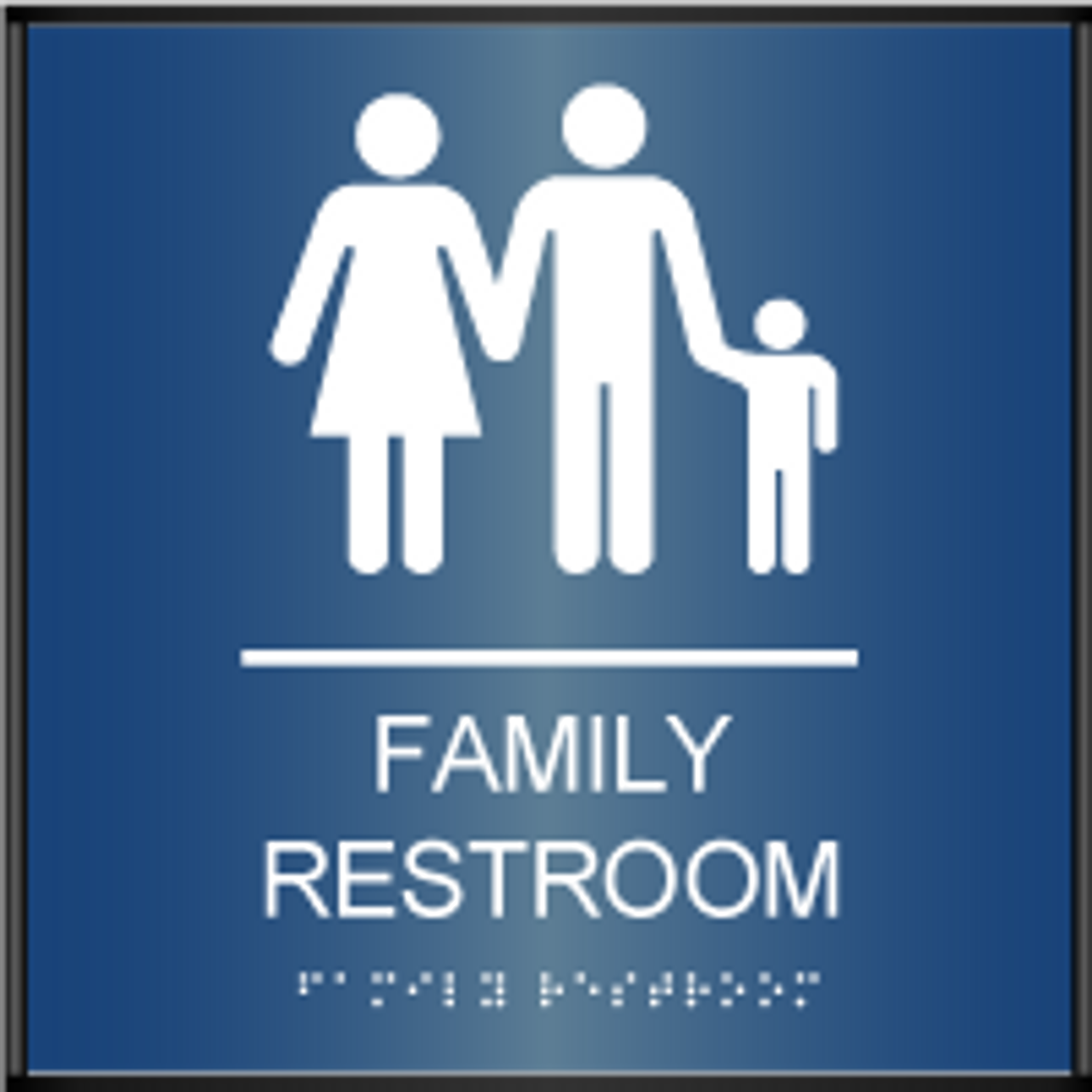
Family restroom signs are typically designed to be easily recognizable and accessible to families with young children or individuals with disabilities. They often incorporate specific design elements to convey their purpose and accommodate the needs of users.
Colors
Family restroom signs commonly use specific colors to indicate their purpose. For example, blue and pink are often used to represent male and female restrooms, respectively, while green is often used for family restrooms. These colors help users quickly identify the type of restroom they are looking for.
Symbols
Symbols are another important design element used in family restroom signs. The international symbol for a family restroom, which consists of a stylized figure of a parent and child, is widely recognized and used to indicate that the restroom is accessible to families.
Fonts
The font used in family restroom signs should be clear and easy to read. Sans-serif fonts, such as Arial or Helvetica, are commonly used because they are easy to read from a distance.
Effective Family Restroom Sign Designs
Effective family restroom signs are designed to be clear, concise, and easy to understand. They should use appropriate colors, symbols, and fonts to convey their purpose and accommodate the needs of users.
Placement and Visibility
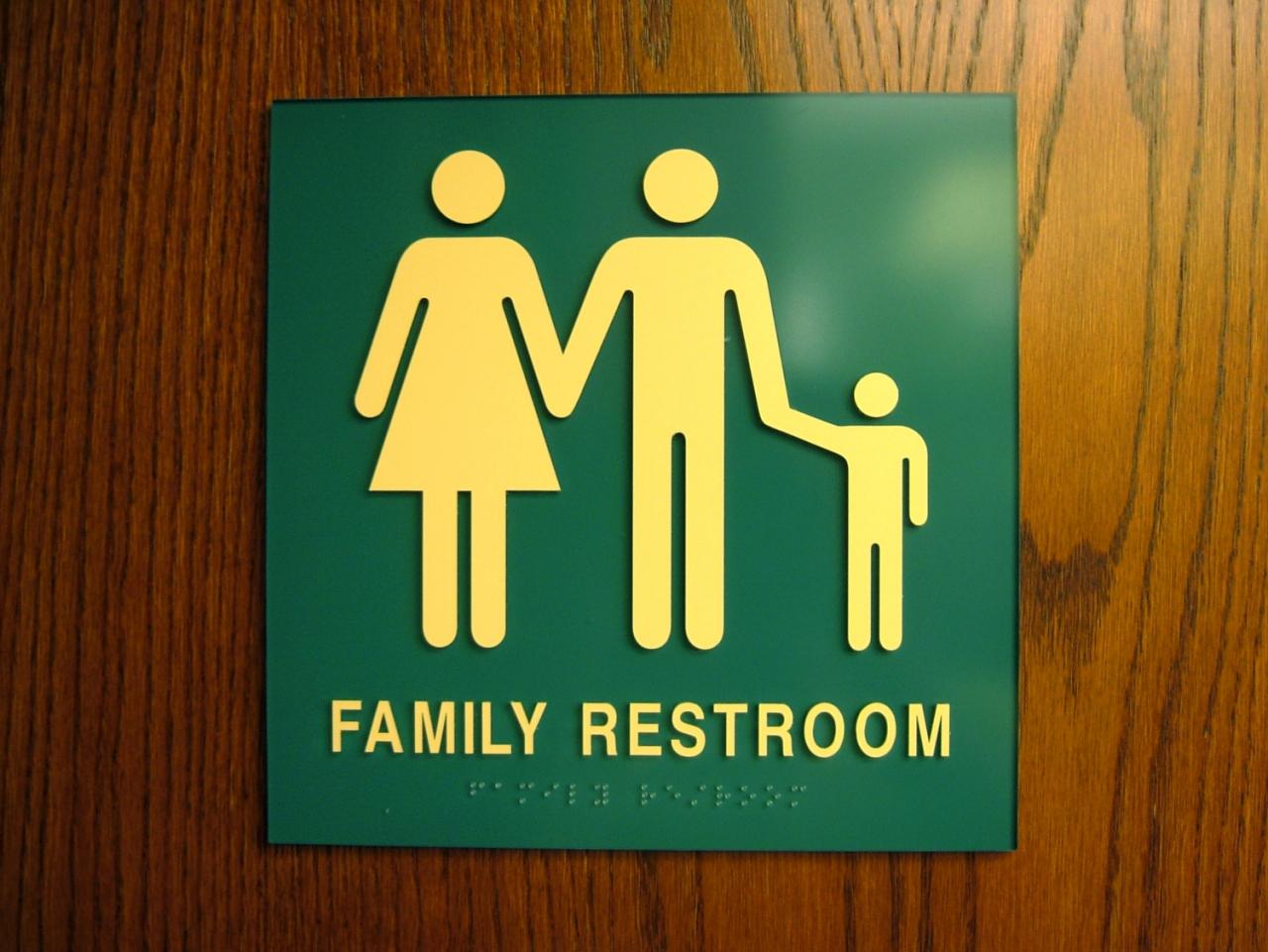
Effective placement of family restroom signs is crucial to ensure they are easily noticeable by patrons. Consider the following factors:
Traffic Flow and Accessibility
Identify areas with high foot traffic, such as entrances, exits, or common gathering points. Ensure signs are placed at eye level, avoiding obstructions like pillars or walls. Consider accessibility for individuals with disabilities, placing signs at appropriate heights and providing clear pathways.
Best Practices for Sign Placement
- Public Buildings:Place signs near entrances, restrooms, and elevators.
- Shopping Centers:Position signs at central areas like food courts, customer service desks, or entrances.
- Parks and Recreation Areas:Place signs near playgrounds, picnic areas, or restrooms.
- Schools:Install signs near school entrances, hallways, or gymnasiums.
- Offices:Position signs near reception areas, break rooms, or elevators.
Materials and Durability
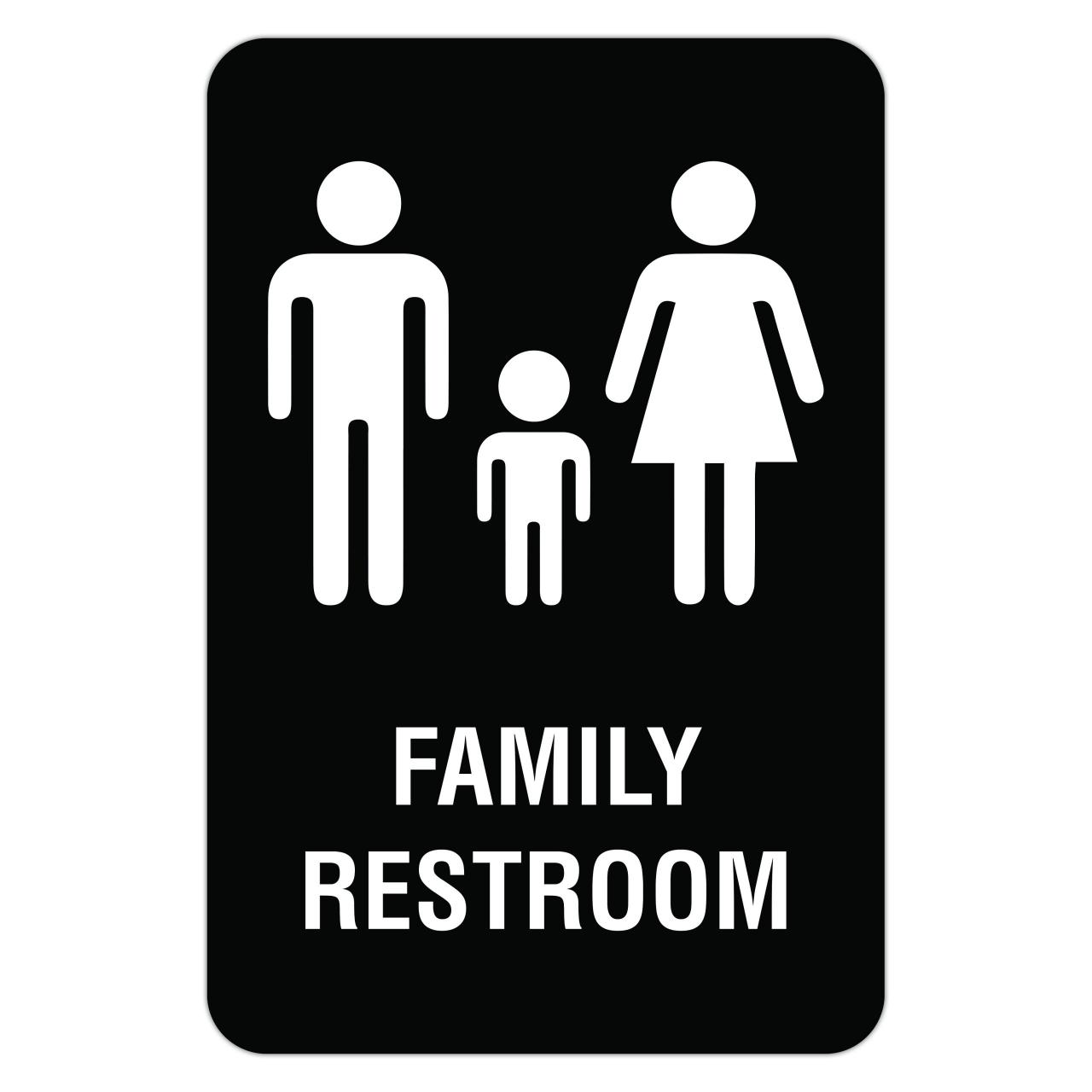
Family restroom signs are subject to wear and tear from frequent use and cleaning. Choosing a durable material is essential to ensure the sign remains legible and effective over time.Factors to consider when selecting a material include the location of the sign, the amount of traffic it will receive, and the cleaning methods used.
For high-traffic areas, materials such as metal or acrylic are recommended for their durability and resistance to scratching. In areas where signs are exposed to moisture or chemicals, materials like stainless steel or plastic are preferred for their corrosion resistance.
Durable Materials
- Metal:Metal signs are highly durable and resistant to wear and tear. They are a good choice for high-traffic areas and can withstand harsh cleaning methods.
- Acrylic:Acrylic is a lightweight and shatter-resistant material that is also resistant to fading and scratching. It is a good option for indoor and outdoor use.
- Stainless steel:Stainless steel is a corrosion-resistant material that is easy to clean and maintain. It is a good choice for areas where signs are exposed to moisture or chemicals.
- Plastic:Plastic signs are lightweight and inexpensive. They are a good option for indoor use, but they may not be as durable as other materials in high-traffic areas.
Compliance and Regulations
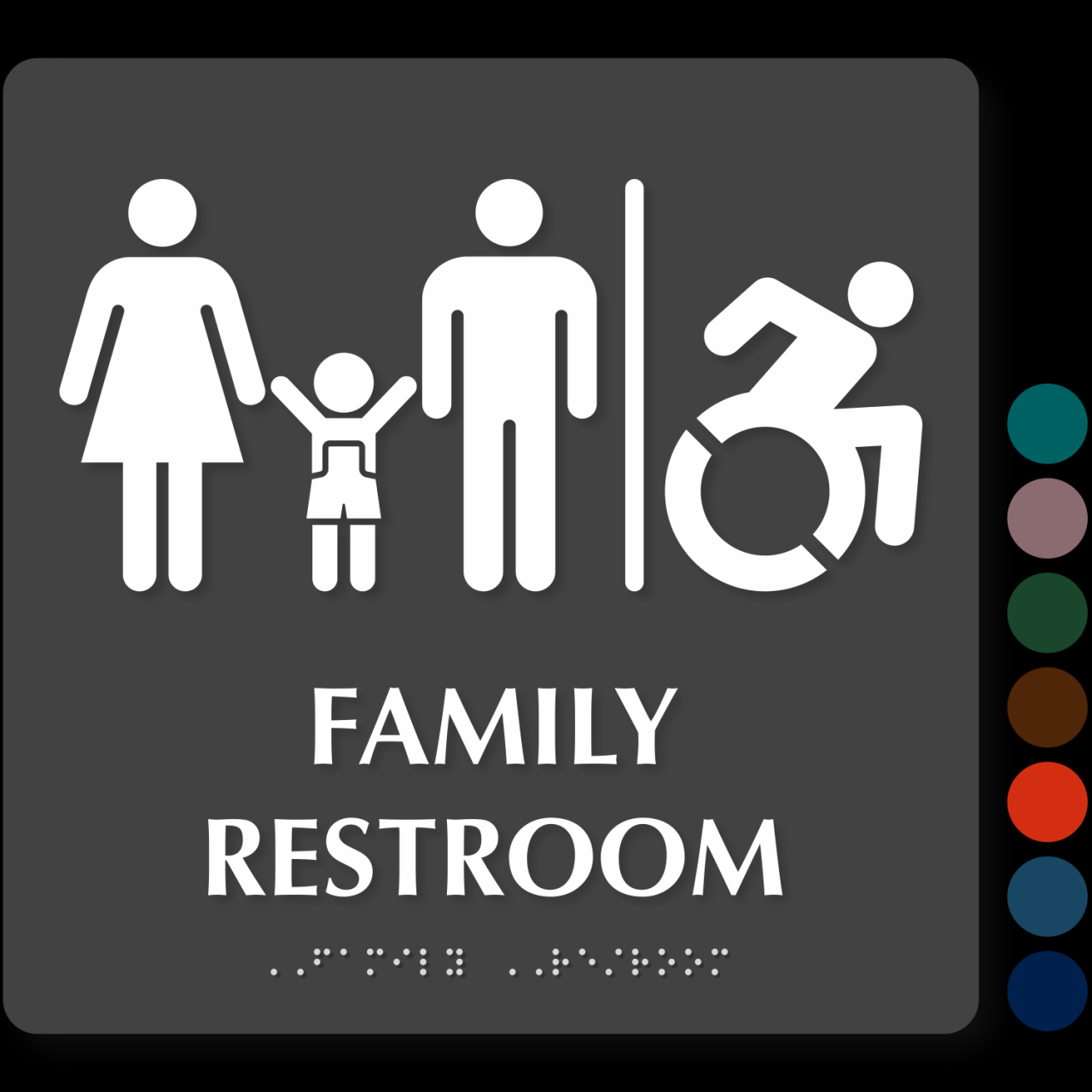
Family restroom signs are subject to various regulations and standards that ensure accessibility and compliance with building codes. These guidelines aim to create inclusive and safe spaces for individuals and families with diverse needs.
It is crucial to adhere to these regulations to ensure that family restrooms meet the required standards and provide a welcoming and accessible environment for all users.
Regulations and Standards
Regulations and standards governing family restroom signs vary depending on the jurisdiction. Some common guidelines include:
- The Americans with Disabilities Act (ADA) in the United States
- The Building Code of Australia (BCA)
- The National Building Code of Canada (NBCC)
- The Uniform Building Code (UBC)
These regulations Artikel specific requirements for family restroom signs, such as:
- Size and placement
- Font and color contrast
- Symbol and language requirements
Accessibility Guidelines
Accessibility guidelines are essential in ensuring that family restrooms are accessible and usable by individuals with disabilities. These guidelines include:
- Clear and visible signage
- Accessible height and reach
- Non-slip flooring
- Adequate space for wheelchairs
By following accessibility guidelines, family restrooms can be made more inclusive and welcoming for all.
Compliant Family Restroom Signs
Compliant family restroom signs meet the requirements of relevant regulations and standards. They typically include:
- The international symbol of accessibility (ISA)
- Clear and legible text
- Contrasting colors for visibility
- Appropriate size and placement
Compliant signs ensure that family restrooms are easily identifiable and accessible to all users.
Inclusive Language and Symbolism
Using inclusive language and symbolism on family restroom signs is crucial for creating a welcoming and comfortable environment for all users. Inclusive language and symbolism convey respect and acceptance, fostering a sense of belonging for individuals of all backgrounds and identities.
There are several ways to incorporate inclusivity into sign design. One approach is to use gender-neutral language, such as “family restroom” or “all-gender restroom,” instead of “men’s room” or “women’s room.” Another strategy is to employ universal symbols that represent all genders, such as a figure with a skirt or pants, or a combination of both.
Symbolism
Symbols can be a powerful tool for promoting inclusivity. By using symbols that represent different genders and identities, restrooms can become more welcoming and accessible for all users. Some examples of inclusive symbols include:
- A figure with a skirt or pants, or a combination of both
- A silhouette of a pregnant person
- A symbol of a wheelchair
- A symbol of a baby changing station
Signage Systems: Family Restroom Sign
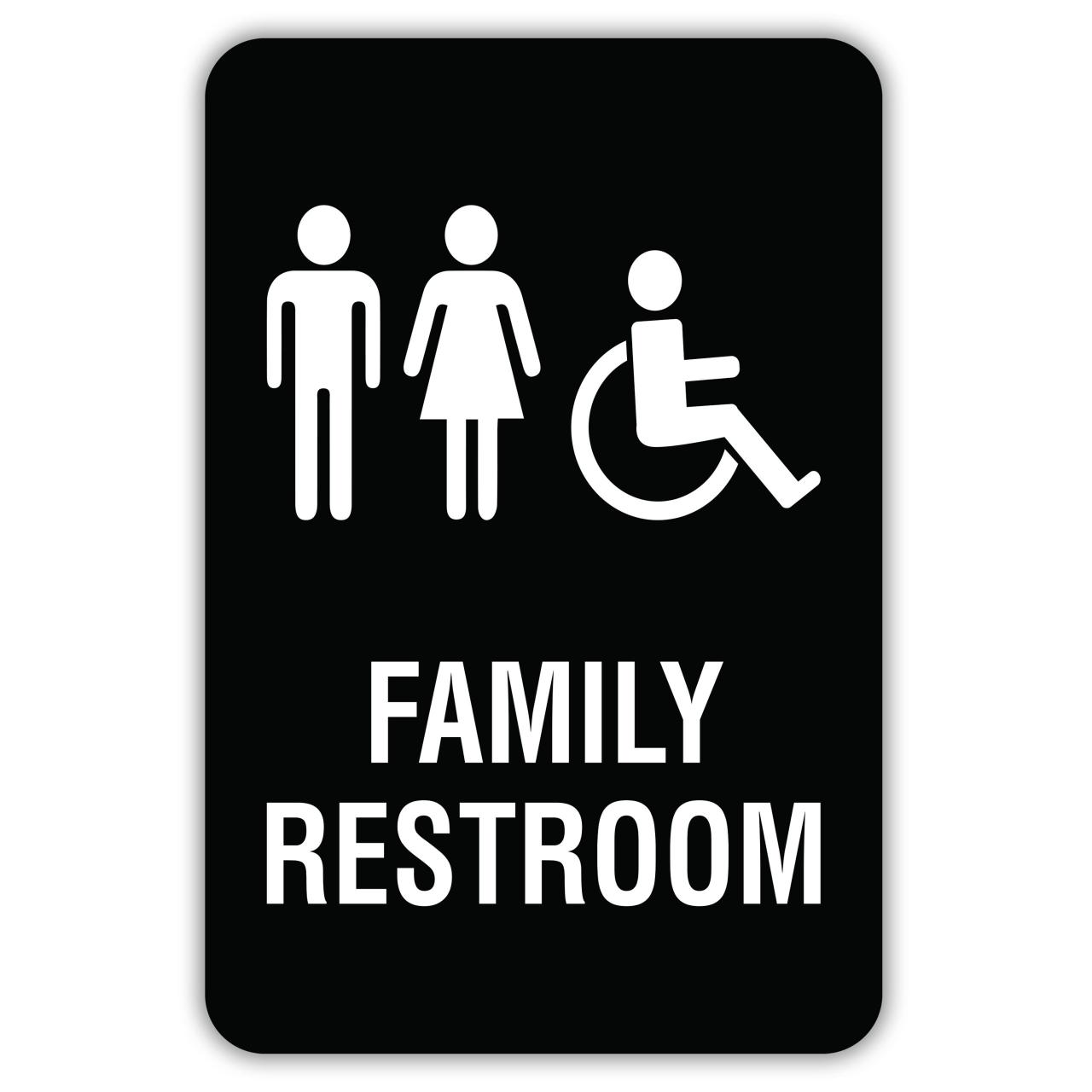
Signage systems play a crucial role in directing people to family restrooms, ensuring easy accessibility and convenience. Different types of signage systems cater to specific building designs, visitor demographics, and accessibility needs.
The choice of signage system depends on factors such as the size of the building, the number of floors, the target audience, and the budget. It’s important to consider the advantages and disadvantages of each system to determine the most effective solution for a particular facility.
Types of Signage Systems
- Static Signage:Permanent signs made of durable materials like metal or plastic, mounted on walls or posts. They provide clear directions but lack interactivity or real-time information.
- Digital Signage:Electronic displays that can display dynamic content, such as real-time restroom availability, directions, and other relevant information. They offer flexibility and the ability to update information remotely.
- Interactive Signage:Touchscreen or button-operated displays that allow users to interact with the signage, such as obtaining directions, accessing building information, or requesting assistance.
- Wayfinding Signage:Comprehensive systems that combine static, digital, and interactive elements to provide comprehensive navigation throughout a building. They offer a user-friendly and intuitive way to locate family restrooms.
Examples of Effective Signage Systems
For Small Buildings:Static signage with clear and concise directions is sufficient for small buildings with a limited number of restrooms.
For Multi-Floor Buildings:Wayfinding signage with digital directories and interactive maps can help visitors navigate large buildings with multiple floors.
For Buildings with High Visitor Traffic:Digital signage with real-time restroom availability information can reduce wait times and improve the overall user experience.
Digital Signage
Digital signage can be an effective way to communicate information about family restrooms, such as their location, hours of operation, and amenities. Digital signs can be updated easily and quickly, which makes them ideal for displaying real-time information. They can also be used to display engaging content, such as videos or interactive maps, which can help to make the restroom experience more enjoyable for families.
Benefits of Using Digital Signs
There are several benefits to using digital signs for family restrooms, including:
- Flexibility:Digital signs can be easily updated and changed, which makes them ideal for displaying real-time information.
- Engaging:Digital signs can be used to display engaging content, such as videos or interactive maps, which can help to make the restroom experience more enjoyable for families.
- Cost-effective:Digital signs can be a cost-effective way to communicate information about family restrooms, especially when compared to the cost of printing and distributing traditional signs.
Limitations of Using Digital Signs
There are also some limitations to using digital signs for family restrooms, including:
- Reliability:Digital signs can be unreliable, especially if the network connection is lost or if the sign is not properly maintained.
- Cost:Digital signs can be more expensive than traditional signs, especially if they are large or if they require special installation.
- Accessibility:Digital signs may not be accessible to everyone, especially people with disabilities or who do not speak the language displayed on the sign.
Examples of Innovative and Engaging Digital Signage Solutions
There are many innovative and engaging digital signage solutions that can be used for family restrooms. Some examples include:
- Interactive maps:Interactive maps can help families find the nearest family restroom, as well as other amenities such as changing tables and nursing rooms.
- Videos:Videos can be used to provide information about the family restroom, such as its hours of operation and amenities.
- Games:Games can be used to make the restroom experience more enjoyable for children.
Maintenance and Upkeep
Regular maintenance and upkeep are crucial for ensuring family restroom signs remain effective and accessible. These signs must be kept clean, legible, and in good repair to fulfill their purpose of providing a safe and inclusive environment for families.
Cleaning and Inspection
Signs should be cleaned regularly to remove dirt, dust, and debris that can obscure visibility. Cleaning frequency may vary depending on the environment and usage, but a general guideline is to clean signs at least monthly. Regular inspections should also be conducted to check for any damage or wear that may require repairs.
Repairs and Replacements
If signs are damaged or become illegible, prompt repairs or replacements should be made. Minor repairs, such as fixing loose screws or replacing faded lettering, can often be handled in-house. However, for more significant damage, it may be necessary to contact a professional sign company.
Tips for Maintenance
* Use mild cleaning solutions and avoid abrasive materials that could damage the sign’s surface.
- Check for any loose screws or bolts and tighten them as needed.
- Replace any faded or damaged lettering promptly.
- Keep a record of maintenance and repairs performed for future reference.
By adhering to regular maintenance and upkeep, family restroom signs can maintain their visibility, functionality, and inclusivity, ensuring they continue to meet the needs of families and contribute to a positive and welcoming environment.
Case Studies
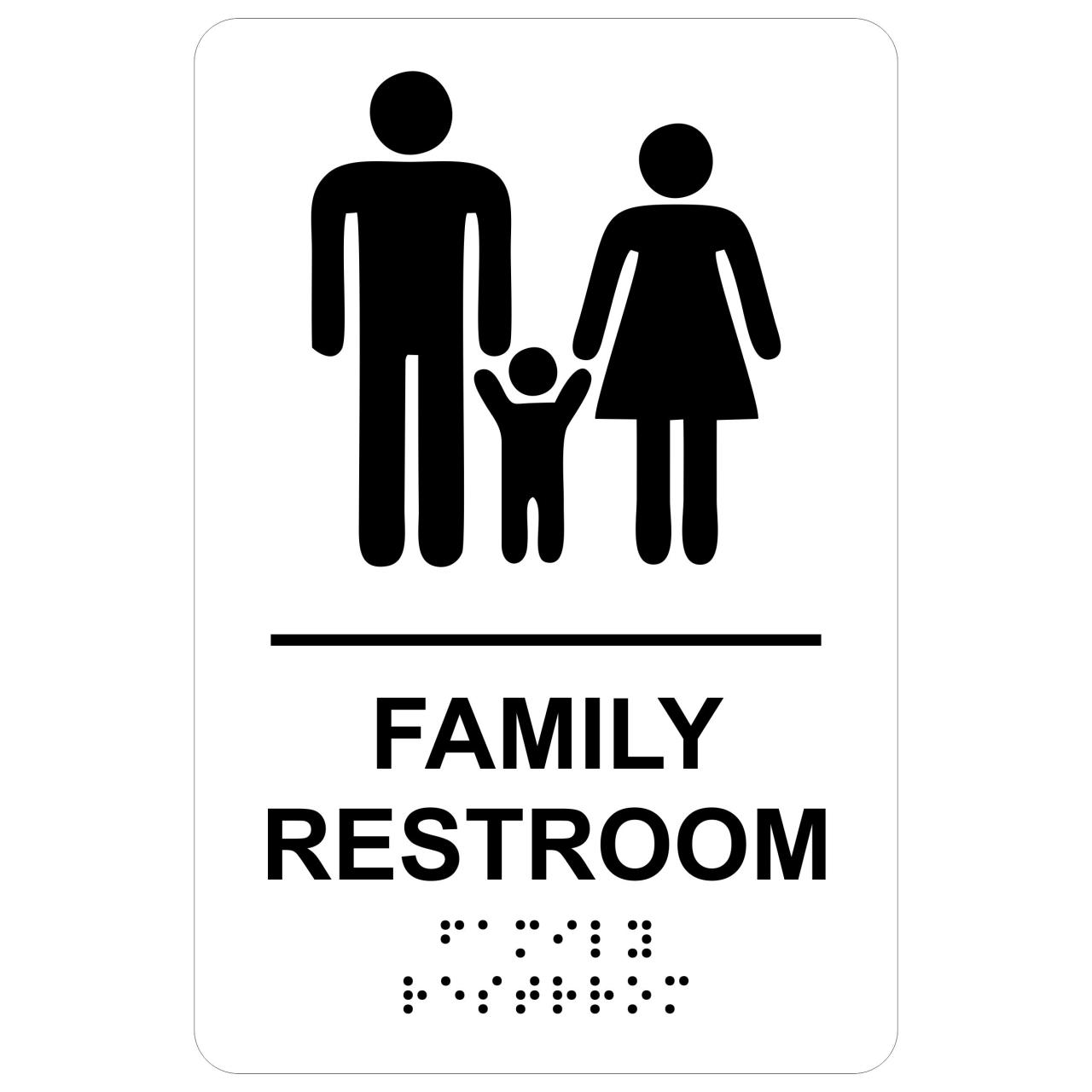
In this section, we present real-world examples of successful family restroom sign implementations, highlighting the challenges faced and the solutions adopted to enhance accessibility and inclusivity.
Case Study: [Case Study Name]
In [year], [organization name] implemented a comprehensive family restroom signage system at its [location] facility. The initiative aimed to address the lack of accessible and inclusive restroom facilities for families with young children, individuals with disabilities, and caregivers.
The primary challenge was to create signage that was clear, easy to understand, and visible from a distance. The solution involved using high-contrast colors, large fonts, and pictograms that conveyed the message effectively.
The signage system was placed at strategic locations throughout the facility, ensuring visibility and accessibility. It included signs indicating the location of family restrooms, as well as signs within the restrooms providing guidance on how to use the facilities.
The implementation of this signage system resulted in a significant improvement in the accessibility and inclusivity of the restroom facilities. Families with young children, individuals with disabilities, and caregivers could now easily locate and use the restrooms, enhancing their overall experience at the facility.
Case Study: [Case Study Name]
[Organization name] faced a similar challenge at its [location] facility. The existing restroom signage was outdated, confusing, and not inclusive of all users.
The solution involved a complete redesign of the signage system, using inclusive language and symbols that catered to a diverse user base. The new signs were designed to be visually appealing, easy to understand, and compliant with accessibility standards.
The signage system was implemented throughout the facility, including restrooms, hallways, and common areas. The result was a significant improvement in the visibility, clarity, and inclusivity of the restroom facilities.
These case studies demonstrate the positive impact that effective family restroom signage can have on accessibility and inclusivity. By addressing the challenges of visibility, clarity, and inclusivity, organizations can create restroom facilities that meet the needs of all users.
Future Trends
The future of family restroom sign design is characterized by innovation, technology, and inclusivity. As technology advances and societal norms evolve, so too will the design and implementation of family restroom signs.
One emerging trend is the use of digital signage. Digital signs offer several advantages over traditional static signs. They can be easily updated with new information, making them ideal for displaying real-time availability or providing additional instructions. Additionally, digital signs can be customized to match the specific needs of each facility, including language translation and accessibility features.
Innovative Sign Solutions
Some innovative and forward-thinking sign solutions include:
- Gender-neutral signage:This type of signage does not specify a specific gender, making it more inclusive for individuals who do not identify with traditional gender categories.
- Signage with pictograms:Pictograms are simple, universally recognized symbols that can convey information without the use of words. This makes them ideal for restrooms that are used by people from different linguistic backgrounds.
- Signage with Braille and tactile features:These features make it easier for people with visual impairments to locate and use restrooms.
Design Guide
Creating effective family restroom signs requires careful consideration of design elements and best practices. This guide provides a comprehensive overview of sign design, including templates, examples, and resources to assist designers and sign makers.
Sign Design Elements, Family restroom sign
- Clarity and Conciseness:Signs should convey their message clearly and concisely, using simple language and avoiding unnecessary details.
- Legibility and Contrast:Font size, color, and contrast should ensure that signs are easy to read from a distance.
- Visual Impact:Signs should attract attention and be visually appealing, using colors, shapes, and graphics that enhance their visibility.
- Durability:Signs should be made of durable materials that can withstand wear and tear in public restrooms.
Final Summary
In conclusion, family restroom signs are essential components of accessible and inclusive public spaces. By following the guidelines and recommendations Artikeld in this guide, organizations can create signs that are clear, visible, and welcoming to all. These signs not only provide direction but also convey a message of inclusivity and respect, fostering a positive and equitable experience for everyone.
